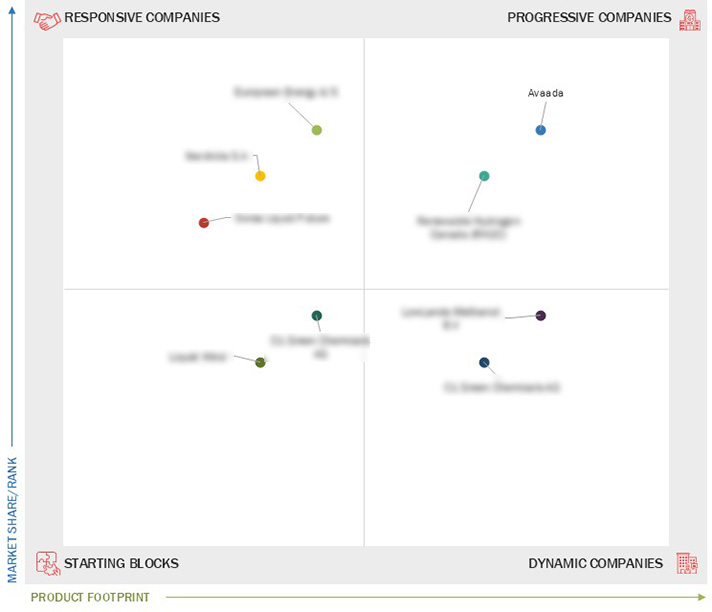Comparing 8 vendors in Green Methanol Startups across 0 criteria.
The green methanol market is gaining momentum due to its potential as a sustainable alternative to fossil fuels. Produced from renewable sources, green methanol supports global decarbonization efforts by significantly reducing harmful emissions. It is increasingly used in transportation, especially in automotive and maritime sectors, due to its compatibility with existing engines and infrastructure. Additionally, its role in producing biodiesel and formaldehyde-based resins makes it valuable in construction and manufacturing. Government policies and environmental goals are further accelerating its adoption across industries.
Market Leadership Quadrant
1.1 Study Objectives
1.2 Market Definition
1.3 Study Scope
1.3.1 Markets Covered and Regional Scope
1.3.2 Inclusions and Exclusions
1.3.3 Years Considered
1.4 Currency Considered
1.5 Unit Considered
1.6 Limitations
1.7 Stakeholders
2.1 Introduction
2.2 Market Dynamics
2.2.1 Drivers
2.2.1.1 Increasing demand for sustainable and renewable energy
2.2.1.2 Demand for green methanol in automotive and construction industries
2.2.2 Restraints
2.2.2.1 Competing fuel options – ethanol, hydrogen, and biodiesel
2.2.3 Opportunities
2.2.3.1 Green methanol as alternative fuel in marine and manufacturing industrie
2.2.3.2 Green methanol fuel cells in transportation and energy sectors
2.2.4 Challenges
2.2.4.1 Cost competitiveness to produce green methanol
2.2.4.2 Consumer awareness about benefits of green methanol
2.2.4.3 Infrastructure, scale, and efficiency limitations for production
2.3 Trends/Disruptions Impacting Customer Business
2.4 Value Chain Analysis
2.5 Ecosystem Analysis
2.6 Investment and Funding Scenario
2.7 Technology Analysis
2.7.1 Key Technologies
2.7.2 Complementary Technologies
2.7.3 Adjacent Technologies
2.8 Patent Analysis
2.9 Trade Analysis
2.10 Porter’s Five Forces Analysis
2.10.1 Threat of New Entrants
2.10.2 Threat of Substitutes
2.10.3 Bargaining Power of Suppliers
2.10.4 Bargaining Power of Buyers
2.10.5 Intensity of Competitive Rivalry
3.1 Introduction
3.2 Key Player Strategies/Right to Win
3.3 Revenue Analysis
3.4 Market Share Analysis
3.5 Company Valuation and Financial Metrics
3.6 Brand/Product Comparison
3.7 Company Evaluation Matrix: Startups/SMEs
3.7.1 Progressive Companies
3.7.2 Responsive Companies
3.7.3 Dynamic Companies
3.7.4 Starting Blocks
3.7.5 Competitive Benchmarking: Startups/SMEs
3.7.5.1 Detailed list of key startups/SMEs
3.7.5.2 Competitive benchmarking of key startups/SMEs
3.8 Competitive Scenario
3.8.1 Deals
4.1 Avaada
4.1.1 Business overview
4.1.2 Products/Solutions/Services offered
4.1.3 Recent developments
4.2 C1 Green Chemicals AG
4.2.1 Business overview
4.2.2 Products/Solutions/Services offered
4.2.3 Recent developments
4.3 European Energy A/S
4.3.1 Business overview
4.3.2 Products/Solutions/Services offered
4.3.3 Recent developments
4.4 IBERDROLA, S.A.
4.4.1 Business overview
4.4.2 Products/Solutions/Services offered
4.4.3 Recent developments
4.5 Liquid Wind
4.5.1 Business overview
4.5.2 Products/Solutions/Services offered
4.5.3 Recent developments
4.6 LowLands Methanol B.V.
4.6.1 Business overview
4.6.2 Products/Solutions/Services offered
4.6.3 Recent developments
4.7 Renewable Hydrogen Canada (RH2C)
4.7.1 Business overview
4.7.2 Products/Solutions/Services offered
4.7.3 Recent developments
4.8 Swiss Liquid Future AG
4.8.1 Business overview
4.8.2 Products/Solutions/Services offered
4.8.3 Recent developments


 Meyka
Meyka
 Dec 2025
Dec 2025

